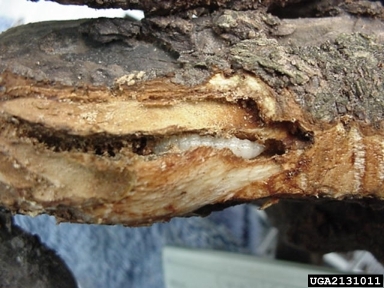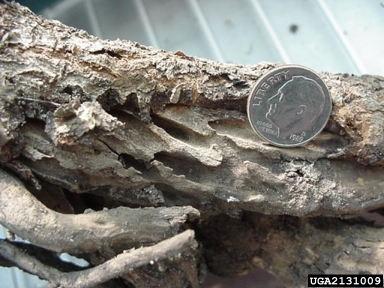Nutrition and Host Interaction
The nutritional needs of the Viburnum
clearwing borer
are provided by consuming the stem bases of the American high
bush cranberry and other Viburnum shrub.
According to
entomologist Jeff Hahn, when in the larval stage,
the immature caterpillars tunnel from the soil line to several
inches below the soil containing the roots of the Viburnum
plant, and then enter the plant by boring holes into its bark
and cambium (2003).
According to
Phil Pellitteri of the UW Insect Diagnostic
Lab, the larvae have the ability to attack the plant from below
the soil line to upwards of 18 inches off the ground.
Chewed, swollen, scarred stems and emergence holes appear
on the plant and give evidence of a borers’ attack (1999).
Once a bush is severely attacked, it shows physical signs
of bare foliage and dieback which can lead to the plant’s death.
Some plants are able to survive borer attacks but often
show signs of callused healing and old scarring (Pellitteri,
1999).
However,
in a research study by
Hartman and Parsons in 2005,
Virburnum
plants located in the community of Green Bay, Wisconsin were
donated to the study and dissected for observation of Virburnum
borer damage. They
found that unlike the current literature on the feeding behavior
of the borer, evidence found that borers did in fact create
galleries in the cambium of the plant, but also seem to prefer
the areas where the plant is attempting to callus over and heal
its damage. Hartman
and Parsons hypothesize that this is because the bug prefers
this area containing plant growing material which is extremely
nutritious (Hartman et al. 2005).
Additionally, their observations have lead to the
hypothesis that plants baring signs of previous Virburnum borer
damage are sought out and preferred by adult egg laying
Virburnum moths.
Therefore, once a plant becomes infested, it has a high
probability of never escaping invasion and eventually dying from
the damage (Hartman et al., 2005).
Often, a Viburnum borer will prey on
unhealthy and weak bushes verses healthy, successful
counterparts (Pellitteri 1999).
As D.A. and M.F. Potter of the University of Kentucky
point out, a borer is able to dramatically decrease the health
and possibly kill a Viburnum plant by damaging the plant’s
vascular system. The
vascular system is located just behind the bark of the shrub and
is responsible for carrying the proper nutrients throughout the
plant for survival.
When the vascular system is eaten away by the borer, the tree is
unable to effectively distribute its metabolic needs.
Therefore, in a relatively short time ranging from one to
three years, the plant can lose its ability to function properly
and die (Potter et al., 2008). Because of the nature of the
dietary behavior of this insect, it has been regarded as pest
species leading to the destruction and reduction consequences it
has for Viburnum plant species.
Records show documentation of considerable damage in the
states that encompass the Great Lakes Region (Etes 2012).

